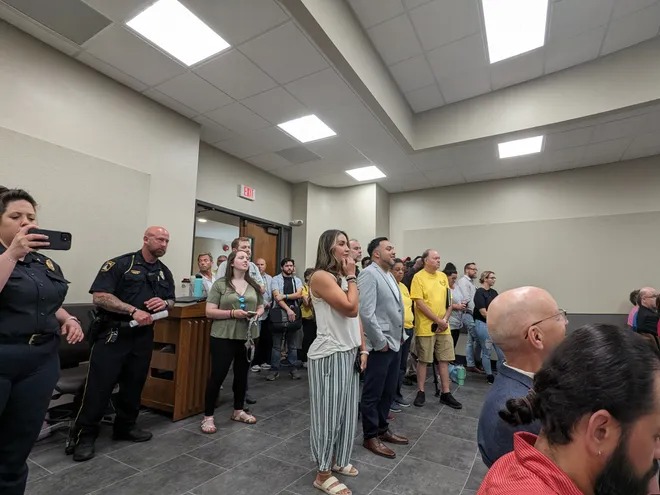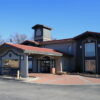By Stacey Saldanha-Olson and Tim Hrenchir, Topeka Capital-Journal
Topeka’s city government has a long history of commissioning consultant reports that end up gathering dust on shelves.
That must not happen with the report on how to mitigate homelessness unveiled at the May 21 Topeka City Council meeting, the mayor and council heard from a former homeless man who helped put it together.
Topeka JUMP homeless task force member Matthew Whitney expressed support at Tuesday’s meeting for the report’s recommendations, including building a low-barrier shelter that has fewer restrictions on who can come in.
“I think that (Brianna) Sylver did an excellent job of showing not only how a low-barrier shelter could possibly benefit the city of Topeka, but the tiny homes as well,” Whitney said. “They’re both viable options for starting to move in the right direction.”
Barry Feaker, former longtime director of TRM Ministries Inc. and now CEO and lead coach for Topeka-based Compassion Strategies, is optimistic the plan will be effective, he told The Capital-Journal after Tuesday’s meeting.
“I think there are enough organizations and individuals that are collating together that we can go for it,” said Feaker, who was among those who helped put the plan together.
Why did Topeka city government seek homelessness counsel?
A group formed by Topeka’s city government has worked since September with Sylver, president of Sylver Consulting, which the mayor and council voted to hire for $76,080 in February 2023 to help the city use the Path to Innovation methodology to help the Topeka community aid the homeless in a more proactive and humane matter.
The move came amid public concerns that homeless camps were creating eyesores and public health concerns here.
The city’s 2023 Point in Time Homeless count showed Topeka had 412 homeless people, with 157 being unsheltered, meaning they didn’t live in an emergency shelter or transitional housing. Results hadn’t been made public as of Friday for this year’s count, which was taken Jan. 25.
A core team and an auxiliary team created by Topeka’s city government started last year by studying the issues involved. Those teams included community members and representatives of local government and nonprofit organizations.
Those involved then sought to generate solutions at meetings where participants included homeless people and local elected officials.
Next, they narrowed those down to a few concepts that could be the most impactful and meaningful.
Sylver shared information about the plan at Tuesday’s meeting of the Topeka City Council. She said she also plans to make a presentation to the Shawnee County Commission.
What did the Topeka mayor and council say?
Mayor Mike Padilla praised the commitment shown by those who helped create the plan.
“They did this not as a task but more of as a mission for our community,” he said.
Councilman Neil Dobler noted that after all the time that was put into crafting a plan, it contains many of the same elements — such as a resources center, low-barrier shelter and a tiny homes village — that city officials were discussing two or more years ago.
Eventually, Dobler said, “We’re going to arrive at something that works for the people.”
The unveiling of the plan comes a full 15 months after the city hired Sylver Consulting because the mayor and council voted last July to restart the process.
The move canceled steps taken regarding homelessness under the direction of former city manager Stephen Wade, whom a city spokeswoman said was fired last July after being involved in an inappropriate relationship with a subordinate.
What are the homelessness plan’s key components?
No votes regarding the plan were taken at Tuesday’s meeting, where Sylver asked the mayor and council to support its key recommendations that the city and its partners create a low-barrier homeless shelter, a tiny homes village and a resource center, or “one-stop shop,” where homeless people could access various services.
Anyone using the resource center would be greeted by “dedicated navigator,” who would become “that person’s ‘person'” and guide them through their process of seeking stability, Sylver said.
The tiny homes village would initially consist of eight homes, each including a small kitchen and bathroom.
The low-barrier shelter would include congregate and noncongregate housing. Users couldn’t bring in weapons but they could bring in pets, Sylver said.
Low-barrier shelters impose minimal requirements upon people who stay there. The shelter operated by TRM Ministries in Topeka isn’t considered low barrier, as it won’t allow people to stay if they’re intoxicated or engaged in drug use. It also doesn’t allow weapons.
Some entity other than the city would operate the proposed low-barrier shelter and tiny homes village, Sylver said.
The city would request proposals or qualifications from applicants in deciding who would run those. The shelter and village wouldn’t necessarily need to be operated by separate entities.
Lawrence Community Shelter operates a low-barrier homeless shelter and a tiny homes village in that community, according to its website.
Councilman Spencer Duncan said this community is doing the right thing by arranging for the low-barrier shelter and tiny homes community to be operated not by the city but by some other entity.
Nationwide, Duncan said, one common theme is that government-operated shelters and communities for the homeless “are not working.”
The efforts that work have been operated by nongovernment entities, with support from government entities and community organizations, he said.
Another vital component of the plan would include collaboration with organizations in town already addressing homelessness and combating things surrounding homelessness like addiction.
Topeka JUMP member says group will advocate but not participate
Whitney — the Topeka JUMP homeless task force member — said JUMP wouldn’t partner with the shelter, one-stop shop or tiny homes because it is only working on the homeless problem as an advocacy group.
“Sylver had made a comment last night to the effect that Topeka JUMP may want to be involved in combining with other resources that are already available in Topeka to create — whether it’s some sort of one-stop center for homelessness or a low barrier shelter or tiny homes,” Whitney said. “I just want to be clear that Topeka JUMP is not interested in being involved in that part of it. I think that was a little bit of a miscommunication.”
What does the plan say about coalitions?
Putting the plan in place will be expensive, Feaker said, while suggesting that not putting it in place would cost even more.
He made reference to assertions by the National Alliance to End Homelessness that one chronically homeless person costs taxpayers an average of $35,578 a year.
The plan’s goals include putting together “a community coalition supporting action that reduces homelessness.”
People here are already on the verge of creating a “multisector approach” to homelessness here that involves the business, government, faith, nonprofit, education, judicial and law enforcement communities, Feaker said.
What’s the Topeka homelessness plan’s timeline?
The plan sets similar timelines for creating the tiny homes village and low-barrier shelter.
Those include calling for the city and its partners to do the following:
• Create a system between May and June to figure out who would like to run the shelter and tiny homes community.
• Bring together interested parties in June.
• Assess the funding interested parties would bring to the projects in October.
• Identify possible sites for the shelter and tiny homes village between October and December.
• Assess what grant funding might be available to help pay costs in November and December.
• Decide who would operate the shelter and tiny homes village between April and June 2025.
• Focus on finding funding for the projects between July and September 2025.
• Buy or lease land for the shelter and tiny homes village between October and December 2025.
• Build the shelter between April and December 2026, and the tiny homes village’s initial eight homes between July and September 2026.
• Move its first residents into the tiny homes village between October and December 2026, and open the low-barrier shelter between January and March 2027.
Some homelessness advocates question building timeline
During Tuesday’s meeting, many members of JUMP came to support the low-barrier shelter. However, many members spoke over the presentation frustrated by the lengthy timeline.
Whitney said he couldn’t speak to the feasibility of an earlier timeline but said he does think the shelter could be completed before 2028.
“I certainly think that there are options that could have it done before 2028,” Whitney said. “But as far as commenting on whether or not it’s feasible, I don’t think I have all the appropriate information to make that call. I think some of the reactions you heard out of anybody in the audience last night is just the strong urge that the community as a whole has to see positive change in the issue that we’re all pretty aware of in Topeka, which is way too many people without shelter.”
During the meeting, multiple city council members also expressed concerns about the timeline, saying incoming Topeka city manager Robert Perez wouldn’t start working until June, which could leave the city behind schedule.
View the original story here.






